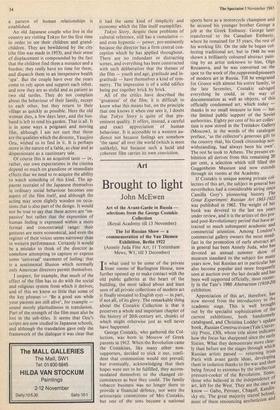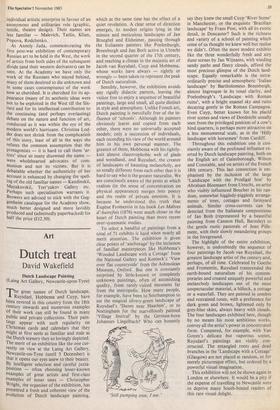Art
Brought to light
John McEwen
Art of the Avant-Garde in Russia - selections from the George Costakis Collection (Royal Academy till 13 November)
The 1st Russian Show — a commemoration of the Van Diemen Exhibition, Berlin 1922 (Annely Juda Fine Art, 11 Tottenham Mews, W I, till 3 December)
In what used to be some of the private front rooms of Burlington House, now further opened up to make contact with the old public galleries at the heart of the building, the most talked about and least seen of all private collections of modern art is finally revealed to English eyes — in part, if not all, of its glory. The remarkable thing about the Costakis Collection is that it preserves a whole and important chapter of the history of 20th-century art, chunks of which might otherwise just as well never have happened.
George Costakis, who gathered the Col- lection, was born in Moscow of Greek parents in 1912. When the Revolution came the Costakises, like many other non- supporters, decided to stick it out, confi- dent that communism would not prevail; but eventually, acknowledging that their hopes were not to be fulfilled, they accom- modated themselves to the changed cir- cumstances as best they could. The family tobacco business was no longer there to provide a financial defence, nor were the aristocratic connections of Mrs Costakis, but one of the sons became a national sports hero as a motorcycle champion and he secured his younger brother George a job at the Greek Embassy. George later transferred to the Canadian Embassy, where he remained for 35 years, the rest of his working life. On the side he began col- lecting traditional art, but in 1946 he was shown a brilliantly coloured abstract pain- ting by an artist unknown to him, Olga Rozanova, and he was converted on the spot to the work of ,the,suppressedipioneers of modern art in Russia. Till he emigrated for Greece with almost his entire family, in the late Seventies, Costakis salvaged everything he could, in the way of documentation as well as objects, of this officially condemned art, which today — thanks in no small measure to him — has the limited public support of the Soviet authorities. Eighty per cent of his art collec- tion is now stored in the Tretiakov Gallery (Moscow), in the words of the catalogue preface, 'as the collector's generous gift to the country that, his Greek citizenship not- withstanding, had always been his own'. The rest he took to Athens. The present ex- hibition all derives from this remaining 20 per cent, a selection which still filled the Guggenheim Museum and now extends through six rooms at the Academy.
If Costakis is unique among private col- lectors of this art, the subject in general has nevertheless had a considerable airing since Camilla Grey's pioneering history The Great Experiment: Russian Art 1863-1922 was published in 1962. The weight of her book was devoted to the last ten years under review, and it is the artists of this pre- and post-Revolutionary period that have at- tracted so much subsequent academic and commercial attention. Among London's commercial gallery owners the most stead- fast in the promotion of early abstract art in general has been Annely Juda, who has devoted an annual summer show of museum standard to the subject for many years now, but Russian art in particular has also become popular and more frequently seen at auction over the last decade and has been well supported officially, most recent- ly in the Tate's 1980 Abstraction (1910-20) exhibition.
Appreciation of this art, therefore, has now moved from the introductory to the academic stage. This is well brought out by the specialist sophistication of the current exhibitions, both handsomely catalogued, and Christina Lodder's update book, Russian Constructivism (Yale Univer- sity Press, £30), whose title alone indicates how the focus has sharpened since the early Sixties. What they demonstrate more clear- ly than before are the stages through which Russian artists passed — returning from Paris with avant garde ideas, developing them in isolation thanks to the war and then being forced to extremes by the intellectual pressure-cooker of the Revolution. Some, those who believed in the independence of art, left for the West. They are the ones we know — Gabo, Pevsner, Chagall, Kandin- sky etc. The great majority stayed behind: most of them renouncing aestheticism and
individual artistic enterprise in favour of an anonymous and utilitarian role (graphic, textile, theatre design). Their names are less familiar — Malevich, Tatlin, Kliun, Popova, Rodchenko.
At Annely Juda, commemorating the first post-war exhibition of contemporary Russian art to be held in the West, the work of artists from both sides of the subsequent divide (and their western derivators) can be seen. At the Academy we have only the work of the Russians who stayed behind, many of them destined to die unknown and in some cases contemptuous of the work now so cherished. It is cherished for its ap- pearance (many of its aesthetic ideas were not to be exploited in the West till the Six- ties) and for its intellectual contribution to the continuing (and perhaps everlasting) debate on the nature and function of art, conducted as it was within the eye of the modern world's hurricane. Christina Lod- der does not shrink from the complication of this story, least of all in the ways she refutes the common assumption that the protagonists — it is hard to call them 'ar- tists' since so many disowned the name were wholehearted advocates of com- munism and not its victims. But it is debatable whether the authenticity of her account is enhanced by changing the spell- ing of the old familiar names — Kandinskii, Mayakovskii, Tret'yakov Gallery etc. Perhaps such specialisation warrants it. Browers are advised to stick with the Gug- genheim catalogue for the Academy show, much better designed and more lavishly Produced and (admittedly paperbacked) for half the price (£12.50).















































 Previous page
Previous page